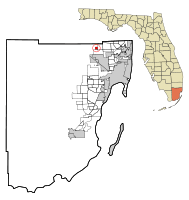Palm Springs North, Florida
| Palm Springs North, Florida | |
|---|---|
| CDP | |
 Location in Miami-Dade County and the state of Florida | |
 U.S. Census Bureau map showing CDP boundaries | |
| Coordinates: 25°55′58″N 80°19′58″W / 25.93278°N 80.33278°WCoordinates: 25°55′58″N 80°19′58″W / 25.93278°N 80.33278°W | |
| Country |
|
| State |
|
| County | Miami-Dade |
| Area | |
| • Total | 0.8 sq mi (2.1 km2) |
| • Land | 0.7 sq mi (1.8 km2) |
| • Water | 0.1 sq mi (0.3 km2) |
| Elevation | 3 ft (1 m) |
| Population (2000) | |
| • Total | 5,460 |
| • Density | 6,825/sq mi (2,600/km2) |
| Time zone | Eastern (EST) (UTC-5) |
| • Summer (DST) | EDT (UTC-4) |
| ZIP code | 33015 |
| Area code(s) | 305 |
| FIPS code | 12-54500[1] |
| GNIS feature ID | 0305079[2] |
Palm Springs North is a census-designated place (CDP) in Miami-Dade County, Florida, United States. The population was 5,253 at the 2010 census.
Geography
Palm Springs North is located at 25°55′58″N 80°19′58″W / 25.93278°N 80.33278°W (25.932904, -80.332871).[3]
According to the United States Census Bureau, the CDP has a total area of 0.8 square miles (2.1 km2), of which, 0.7 square miles (1.8 km2) of it is land and 0.1 square miles (0.26 km2) of it (12.66%) is water.
Demographics
| Historical population | |||
|---|---|---|---|
| Census | Pop. | %± | |
| 1980 | 5,838 | — | |
| 1990 | 5,300 | −9.2% | |
| 2000 | 5,460 | 3.0% | |
| source:[4] | |||
As of the census[1] of 2000, there were 5,460 people, 1,630 households, and 1,449 families residing in the CDP. The population density was 7,885.2 people per square mile (3,055.2/km²). There were 1,656 housing units at an average density of 2,391.6/sq mi (926.6/km²). The racial makeup of the CDP was 93.0% White (of which 33.2% were Hispanic/Latino White,)[5] 0.8% African American, 0.2% Native American, 0.6% Asian, 3.2% from other races, and 2.3% from two or more races.
There were 1,630 households out of which 43.3% had children under the age of 18 living with them, 72.5% were married couples living together, 11.2% had a female householder with no husband present, and 11.1% were non-families. 8.3% of all households were made up of individuals and 3.1% had someone living alone who was 65 years of age or older. The average household size was 3.33 and the average family size was 3.49.
In the CDP the population was spread out with 27.4% under the age of 18, 6.4% from 18 to 24, 31.8% from 25 to 44, 23.4% from 45 to 64, and 11.0% who were 65 years of age or older. The median age was 36 years. For every 100 females there were 96.1 males. For every 100 females age 18 and over, there were 93.4 males.
The median income for a household in the CDP was $62,161, and the median income for a family was $64,428. Males had a median income of $39,886 versus $28,281 for females. The per capita income for the CDP was $20,383. About 3.6% of families and 4.4% of the population were below the poverty line, including 2.1% of those under age 18 and 15.9% of those age 65 or over.
As of 2000, speakers of Spanish as a first language accounted for 67.18% of residents, while English made up 32.8% of the population.[6]
As of 2000, Palm Springs North had the eleventh highest percentage of Cuban residents, with 43.6% of the population,[7] while it had the sixty-third highest percentage of Colombians, at 2.4% of all residents.[8]
Name
The community in named after Palm Springs Estates, an unincorporated community surrounded by the City of Hialeah, just a few miles south.
Education
Public schools that serve Palm Springs North are:
- Palm Springs North Elementary
- Spanish Lake Elementary
- Lawton Chiles Middle school
- American Senior High School and Barbara Goleman Senior High School
Parochial schools that serve Palm Springs North are:
- Mother of Our Redeemer Catholic School
References
- 1 2 "American FactFinder". United States Census Bureau. Retrieved 2008-01-31.
- ↑ "US Board on Geographic Names". United States Geological Survey. 2007-10-25. Retrieved 2008-01-31.
- ↑ "US Gazetteer files: 2010, 2000, and 1990". United States Census Bureau. 2011-02-12. Retrieved 2011-04-23.
- ↑ "CENSUS OF POPULATION AND HOUSING (1790-2000)". U.S. Census Bureau. Retrieved 2010-07-17.
- ↑ "Demographics of Palm Springs North, FL". MuniNetGuide.com. Retrieved 2007-11-07.
- ↑ "MLA Data Center Results of Palm Springs North, FL". Modern Language Association. Retrieved 2007-11-07.
- ↑ "Ancestry Map of Cuban Communities". Epodunk.com. Retrieved 2007-11-07.
- ↑ "Ancestry Map of Colombian Communities". Epodunk.com. Retrieved 2007-11-07.

